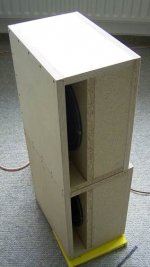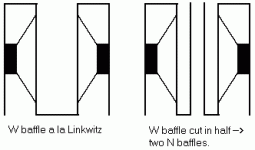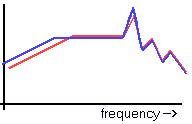That's excellent guys....i just finished reading the entire thread,every post....
i've experimented with dipoles and i know how amazingly open they sound..especially my fullranges (fe167e)..now i want dipole subs too and the room was a major concern for me but now thinking of doing an N frame sub per side is a good start...
what do you think one 15" Warrior per side in N frame is enough for 16'x12'x8' room for music and HT?
I want something cheap but now afraid to buy PPA15 since someone bought them and did not like them and returned them....but then agian chops raves about them...i dunno what to do...don't want to lose $30 in S/H..shipping back and forth.
any suggestions for a driver and/or maybe i need 2 per side?
i've experimented with dipoles and i know how amazingly open they sound..especially my fullranges (fe167e)..now i want dipole subs too and the room was a major concern for me but now thinking of doing an N frame sub per side is a good start...
what do you think one 15" Warrior per side in N frame is enough for 16'x12'x8' room for music and HT?
I want something cheap but now afraid to buy PPA15 since someone bought them and did not like them and returned them....but then agian chops raves about them...i dunno what to do...don't want to lose $30 in S/H..shipping back and forth.
any suggestions for a driver and/or maybe i need 2 per side?
rick57 said:Thanks Frode, guess that's the N baffle.
Any Ripol pics out there?
Rick,
yes, that´s a true N Baffle. Ripols are N baffles with 90° angles instead of 45°. Look at mine. I just cut a W baffle in two and narrowed the openings. That way the driver can better "pressurize" the air in front. Fs is significantly lowered and the 6 dB dipole rolloff is somewhat attenuated. The downside: resonance of the "box" is boosted and must be taken care of with a notch filter.
A commercial site showing ripols in pairs is
http://www.audioelevation.de/attac_serie.htm (sorry, in German)
Attachments
Hi Rudolf
I’ve read a few of your posts and you seem to know your stuff, and I can’t claim I know dipole theory 100% . .
But if Ripols are dipoles with 90° angles (in Linkwitz terms a U frame without the two rear extensions (www.linkwitzlab.com/H-U woofer2.htm) what do you mean by:
- they better "pressurize" the air?
- how would Fs be lowered? (SL www.linkwitzlab.com/models.htm#B says F = 0.25*v/L ie resonance is based on distance front-back. Mu understanding is that if distance is reduced, resonance frequency should increase.
- and how would the 6 dB dipole rolloff point be either lowered or attenuated?
Cheers
I’ve read a few of your posts and you seem to know your stuff, and I can’t claim I know dipole theory 100% . .
But if Ripols are dipoles with 90° angles (in Linkwitz terms a U frame without the two rear extensions (www.linkwitzlab.com/H-U woofer2.htm) what do you mean by:
- they better "pressurize" the air?
- how would Fs be lowered? (SL www.linkwitzlab.com/models.htm#B says F = 0.25*v/L ie resonance is based on distance front-back. Mu understanding is that if distance is reduced, resonance frequency should increase.
- and how would the 6 dB dipole rolloff point be either lowered or attenuated?
Cheers
Hi Rick,
I´ve added a picture showing the transition from a W baffle to a N baffle. Note that I have deliberately shortended the width of the front opening (area is 25-30% of driver Sd). That is the essence of a Ripole. (R stands for the surname of its inventor Al Ridtahler)
Back opening should be just wide enough to accommodate the driver. Some people even put a hole for the magnet into the side baffle to keep the opening narrow.
To give you an idea of real dimensions: http://www.klingtgut-lsv.de/shop/index.html?d_dipolsub_Dipol_Sub_von_Axel_Ridtahler312.htm
Because of the tight volume "seen" by the woofer the "in-box" resonance frequency of the woofer will be significantly lower (~20%) than its free-air resonance (in contrary to a Linkwitz dipole, where free-air resonance is almost equal to the resonance "in-box").
Please keep in mind that above resonance depends on the individual driver. Don´t confuse it with the box resonance of the baffle.
My 2nd picture shows schematically where the difference between a standard dipole and a ripole is (red= standard, blue= ripole).
I´ve added a picture showing the transition from a W baffle to a N baffle. Note that I have deliberately shortended the width of the front opening (area is 25-30% of driver Sd). That is the essence of a Ripole. (R stands for the surname of its inventor Al Ridtahler)
Back opening should be just wide enough to accommodate the driver. Some people even put a hole for the magnet into the side baffle to keep the opening narrow.
To give you an idea of real dimensions: http://www.klingtgut-lsv.de/shop/index.html?d_dipolsub_Dipol_Sub_von_Axel_Ridtahler312.htm
Because of the tight volume "seen" by the woofer the "in-box" resonance frequency of the woofer will be significantly lower (~20%) than its free-air resonance (in contrary to a Linkwitz dipole, where free-air resonance is almost equal to the resonance "in-box").
Please keep in mind that above resonance depends on the individual driver. Don´t confuse it with the box resonance of the baffle.
My 2nd picture shows schematically where the difference between a standard dipole and a ripole is (red= standard, blue= ripole).
Attachments
Hi Rick,
I think its time to remember where my arguments originated from:
In post #358 spots25 asked for a dipole subwoofer where he could squeeze 15" drivers in a narrow space. I wanted to show that by reducing the "box" area in front and back of the driver you can save volume and have some advantage at the same time.
This slimmer chambers are at the heart of the Ripole principle - not a leftover from splitting a standard W baffle. They help to lower the point, where the 6dB roll off starts, by adding some mechanical "air" spring in the equation. This way Ridtahler claims to have lowered the driver resonance from 24 to 14 Hz (depending on driver).
The graph is neither measured nor simulated. It´s just a schematic to show that you gain lower bandwidth at the expense of a more expressed resonance peak.
I´m afraid I can´t dig deeper into this since Ridtahler hasn´t published his equations and all I know is derived from some hints he gave in some german DIY forums like this.
Rudolf
I think its time to remember where my arguments originated from:
In post #358 spots25 asked for a dipole subwoofer where he could squeeze 15" drivers in a narrow space. I wanted to show that by reducing the "box" area in front and back of the driver you can save volume and have some advantage at the same time.
This slimmer chambers are at the heart of the Ripole principle - not a leftover from splitting a standard W baffle. They help to lower the point, where the 6dB roll off starts, by adding some mechanical "air" spring in the equation. This way Ridtahler claims to have lowered the driver resonance from 24 to 14 Hz (depending on driver).
The graph is neither measured nor simulated. It´s just a schematic to show that you gain lower bandwidth at the expense of a more expressed resonance peak.
I´m afraid I can´t dig deeper into this since Ridtahler hasn´t published his equations and all I know is derived from some hints he gave in some german DIY forums like this.
Rudolf
Sorry to pester you with more questions Rudolf, but you have some 1st hand experience in this...Originally posted by Rudolf
Ridtahler hasn´t published his equations
So the basic rule is, the narrow opening shoudl be 25-30% of driver sd?
I am toying with the idea of a Linkwitz W config for 2 beta 15 per side... I tried an H for these drivers & while not bad sounding (needed equalisation) the size is too monstrous for the wife.
I'm wondering whether there's a better AND more wife friendly OB option out there
Cheers
Yes, that´s what Ridthaler recommends. And the back opening should be as narrow as the driver dimensions allow. Possibly you could even fix the polepiece to the cabinet somehow and thereby reduce basket vibrations.the narrow opening shoud be 25-30% of driver sd?
If you use drivers with 25Hz<Fs(free air)<45Hz Ridthaler claims a reduction of Fs by 10-15Hz. He recommends 15"-18" PA drivers with a semi-hard suspension and Xmax >4-5mm (two 10" drivers per side is what I used). Qts should be at least 0.35. 0.7 would be prefearable, and even Qts=1 is within limits.
Suspension should not be too soft and might even be a bit progressive. The mass of the cone should be on the light side (no 10" with a 120 gr cone please)
Guys,
since I´m a bit busy in my job this week, I can´t go more into detail at the moment. Give me some days and I will post some measurements and the zobel/notch filter Ridthaler recommends.
Thanks for your interest and patience
Rudolf
I was just woundering...
seems to me that if u cram the woofer into small space and force it to compress air so much doesn't it defeat the purpose of open baffle (where woofer is free of any external resistances and moves freely).
I probably don't have enough knowledge on this subject but just seems the response would not be that natural as it would be on OB
If the woofer has to work harder to compress more air - it's similar to adding the mass to the cone. That's the reason the fs goes down, I think.
seems to me that if u cram the woofer into small space and force it to compress air so much doesn't it defeat the purpose of open baffle (where woofer is free of any external resistances and moves freely).
I probably don't have enough knowledge on this subject but just seems the response would not be that natural as it would be on OB
If the woofer has to work harder to compress more air - it's similar to adding the mass to the cone. That's the reason the fs goes down, I think.
@ OTMOPO3OK
Hi OTMOPO3OK,
there is truth in all remarks you made. The Ripol IS a step towards a box design, but it still is a velocity transducer and radiates for the most part in a figure 8. So it still features the most significant attributes of a dipol IMHO.
Certainly a huge flat OB would be more consequent, but some people have to make compromises
Rudolf
Hi OTMOPO3OK,
there is truth in all remarks you made. The Ripol IS a step towards a box design, but it still is a velocity transducer and radiates for the most part in a figure 8. So it still features the most significant attributes of a dipol IMHO.
Certainly a huge flat OB would be more consequent, but some people have to make compromises

Rudolf
Looking forward to yr insight whenever you have time!Posted by Rudolf
I´m a bit busy in my job this week
Ripoles - Honey, I shrunk the dipoles!
Since I didn´t want to hijack this thread any longer, I have started a new one with almost anything about ripoles I could provide:
http://www.diyaudio.com/forums/showthread.php?s=&postid=568432#post568432
Hope I can feed your curiosity
And my apologies to chops who started this in the first place.
Rudolf
Since I didn´t want to hijack this thread any longer, I have started a new one with almost anything about ripoles I could provide:
http://www.diyaudio.com/forums/showthread.php?s=&postid=568432#post568432
Hope I can feed your curiosity
And my apologies to chops who started this in the first place.
Rudolf
hi there!
very interesting tread!!!
just a question ..........what do you think about this one????
http://www.monacor.de/en/produktseite_carpower.php?artid=1872&spr=FR&typ=u&spr=EN
have a good day!
very interesting tread!!!
just a question ..........what do you think about this one????
http://www.monacor.de/en/produktseite_carpower.php?artid=1872&spr=FR&typ=u&spr=EN
have a good day!
I was about to order a pair of the Pyle woofers, but I realized I have two Panasonic TS-W303 12" subwoofers not currently in use. Based up the T/S specs, are these suitable for dipole use? I thought they might be, because they are marketed as 'free air' subs in the car market.
Qms = -0,698
Qes = 0,323
Qts = 0,60
FS = 35 Hz
Vas = 94
RMS = 160w
Peak = 500w
Db/1w/1m = 93 Db
Resistance = 4ohm
Qms = -0,698
Qes = 0,323
Qts = 0,60
FS = 35 Hz
Vas = 94
RMS = 160w
Peak = 500w
Db/1w/1m = 93 Db
Resistance = 4ohm
JWFokker said:I have two Panasonic TS-W303 12" subwoofers not currently in use. Based up the T/S specs, are these suitable for dipole use
Based on your parameters they should do quite well. But I have only seen PIONEER TS-W303 subs on the net, which seem to have a much higher Fs (64 Hz). You should also look for sufficient Xmax (linear +-6 mm and up) and acceptable MMS (>150g).
Rudolf
- Status
- This old topic is closed. If you want to reopen this topic, contact a moderator using the "Report Post" button.
- Home
- Loudspeakers
- Subwoofers
- My first Dipole Subwoofer!!!


